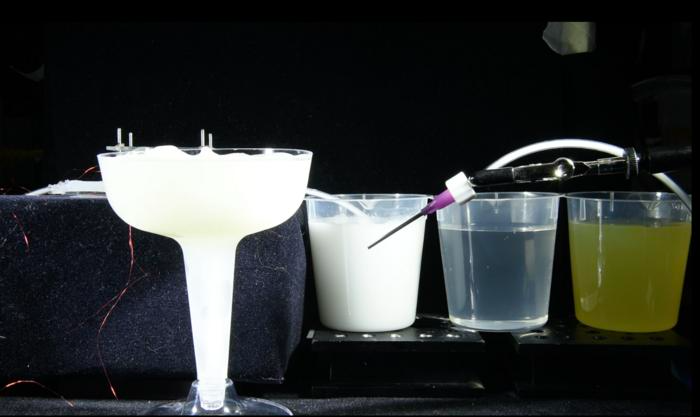
A compact, soft pump with adjustable pressure flow is versatile enough to pump a variety of fluids with varying viscosity, including gin, juice, and coconut milk. Image Credit: Harvard Microrobotics Lab/Harvard SEAS
The pump was built by Wood and his team to address a significant difficulty in soft robotics: how to replace usually bulky and stiff power components with soft alternatives.
Wood’s Microrobotics Lab at SEAS has produced soft analogs of typically rigid robotic components, such as valves and sensors, for several years. Pumps control the pressure or flow of the liquid that powers the robot’s movement in fluid-driven robotic systems.
Most soft robotics pumps on the market today are either too huge and inflexible to fit onboard, insufficiently powerful for actuation, or only function with specific fluids.
Wood’s team created a small, soft pump with adjustable pressure flow that is versatile enough to pump a wide range of viscous fluids, including gin, juice, and coconut milk, and sufficiently powerful to operate soft haptic devices and a soft robotic finger.
The pump’s size, power, and versatility bring up new possibilities for soft robotics in a variety of applications, including food handling, manufacturing, and biomedical therapies.
The findings were just published in Science Robotics.
Industrial settings frequently employ peristaltic pumps. In these simple devices, a flexible tube is compressed by motors, resulting in a pressure differential that pushes the liquid through the tube. Since the fluid does not touch any pump internals, these types of pumps are very helpful in biomedical applications.
Peristaltic pumps can deliver liquids with a wide range of viscosities, particle-liquid suspensions, or fluids such as blood, which are challenging for other types of pumps.
Siyi Xu, Study First Author and Postdoctoral Fellow, John A. Paulson School of Engineering and Applied Sciences, Harvard University
Xu and the team created electrically powered dielectric elastomer actuators (DEAs) to serve as the pump’s motor and rollers based on earlier research. These soft actuators are lightweight, have an extremely high-power density, and can operate for millions of cycles.
The group created an array of DEAs that work in concert to compress a millimeter-sized channel in a predetermined order to generate pressure waves.
The end product is a centimeter-sized pump with controlled pressure, flow rate, and flow direction that is small enough to fit on a little soft robot and powerful enough to initiate movement.
Xu added, “We also demonstrated that we could actively tune the output from continuous flow to droplets by varying the input voltages and the outlet resistance, in our case the diameter of the blunt needle. This capability may allow the pump to be useful not only for robotics but also for microfluidic applications.”
Wood stated, “The majority of soft robots contain rigid components somewhere along their drivetrain. This topic started as an effort to swap out one of those key pieces, the pump, with a soft alternative. But along the way we realized that compact soft pumps may have far greater utility, for example in biomedical settings for drug delivery or implantable therapeutic devices.”
Mohammad Souri and Cara M. Nunez collaborated on the research. The National Science Foundation funded it with grant CMMI-1830291.
Soft robot pump powers soft robots, makes cocktails
Video Credit: Harvard John A. Paulson School of Engineering and Applied Sciences
Journal Reference
Xu, S., et al. (2023) A compact DEA-based soft peristaltic pump for power and control of fluidic robots. Science Robotics. doi:10.1126/scirobotics.add4649.